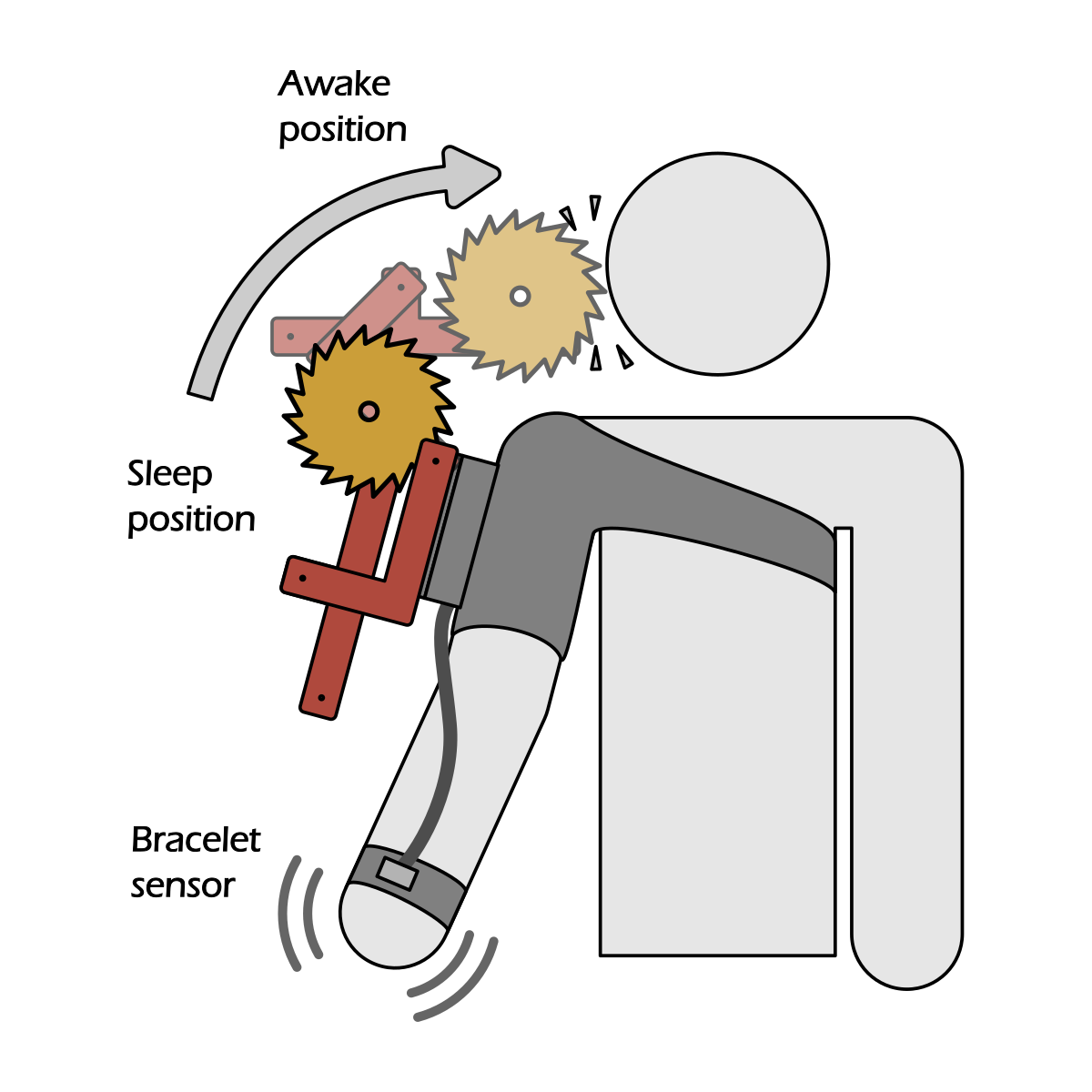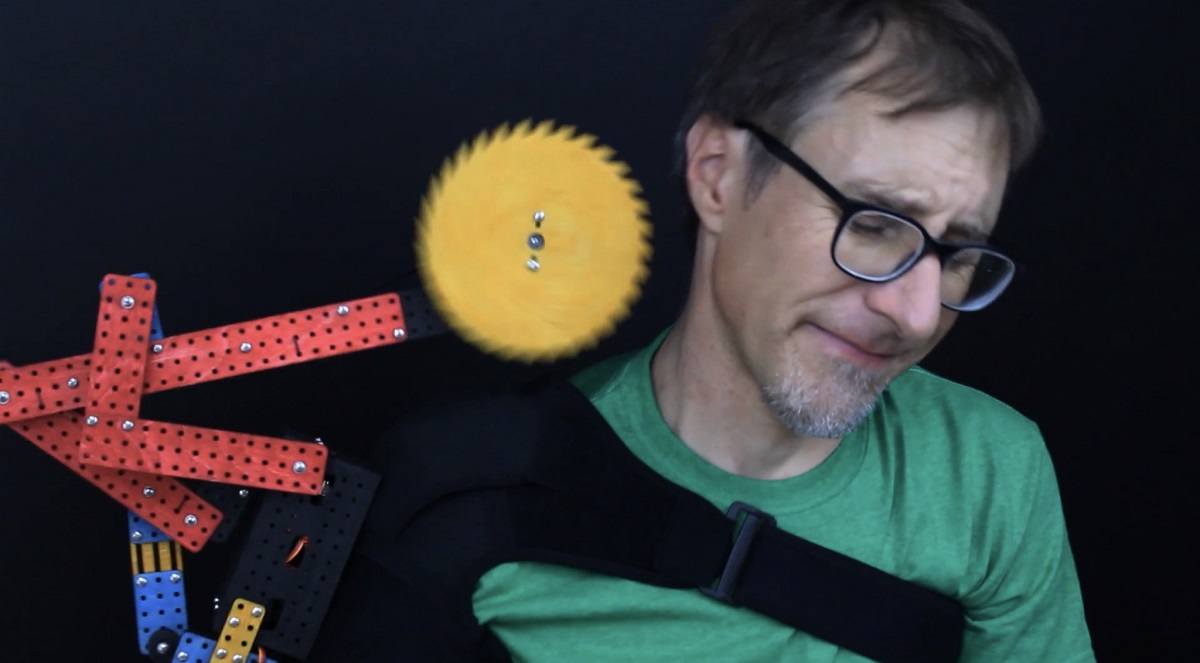Gilbert is a cybernetic, wearable, performance-based artwork. When joined with a host, Gilbert serves as a theatrical abstraction of Tourette Syndrome.
Read my article: Twentysomethings, Tourette Syndrome, and TikTok
Gilbert is part of the ongoing Tourette-O-Tron series in which artifacts are designed to turn the host into a Tourettic cyborg – to induce specific Tourettic motor tics in the user. Sensors allow these devices to interpret the behavior of the human host, and analog programming creates the fluid responsive behavior required to simulate a disorder like Tourette’s.
The work consists of an off-the-shelf shoulder-harness that has been modified to carry the robot and its power supply. When worn and activated, Gilbert enters a collaborative, cybernetic relationship with the human host.
 Gilbert has an internal state that can move between “sleep” and “awake”. When Gilbert is sleeping, there is no activity, and the robot simply rests on the host’s shoulder. As Gilbert wakes up, its mechanical arm begins to extend, and the saw blade begins to rotate. As Gilbert remains awake, the arm continues to move the saw blade toward the host’s head. To stop the robot from colliding with their head, the host must correctly execute a Tourettic tic gesture.
Gilbert has an internal state that can move between “sleep” and “awake”. When Gilbert is sleeping, there is no activity, and the robot simply rests on the host’s shoulder. As Gilbert wakes up, its mechanical arm begins to extend, and the saw blade begins to rotate. As Gilbert remains awake, the arm continues to move the saw blade toward the host’s head. To stop the robot from colliding with their head, the host must correctly execute a Tourettic tic gesture.
 The interface is designed as a theatrical abstraction of one of the artist’s childhood tics. During this period, his Tourette’s would often present as an axial rotation of the wrist. To target this specific behavior in the host, Gilbert has a wrist strap (bracelet) that contains and accelerometer and gyroscope to sense the movement of the host’s arm. The host may develop their own personal tic that satisfies Gilbert’s internal state, but it will need to align with Gilbert’s expectations. The rotation of the wrist gesture has deep personal significance for the artist, but for another user may simply serve as a constraint for them to explore.
The interface is designed as a theatrical abstraction of one of the artist’s childhood tics. During this period, his Tourette’s would often present as an axial rotation of the wrist. To target this specific behavior in the host, Gilbert has a wrist strap (bracelet) that contains and accelerometer and gyroscope to sense the movement of the host’s arm. The host may develop their own personal tic that satisfies Gilbert’s internal state, but it will need to align with Gilbert’s expectations. The rotation of the wrist gesture has deep personal significance for the artist, but for another user may simply serve as a constraint for them to explore.
 Once the host has had adequate time to become familiar with Gilbert, the tic gesture becomes second-nature and automatic. This allows for long-form performances (such as a host walking through an exhibition space or performing a mundane task as a context for the Tourettic behavior).
Once the host has had adequate time to become familiar with Gilbert, the tic gesture becomes second-nature and automatic. This allows for long-form performances (such as a host walking through an exhibition space or performing a mundane task as a context for the Tourettic behavior).

Made with...
https://www.gcac.org/
Current New Media festival (Santa Fe, New Mexico, USA)
https://currentsnewmedia.org/
Read my article: Twentysomethings, Tourette Syndrome, and TikTok
Gilbert is part of the ongoing Tourette-O-Tron series in which artifacts are designed to turn the host into a Tourettic cyborg – to induce specific Tourettic motor tics in the user. Sensors allow these devices to interpret the behavior of the human host, and analog programming creates the fluid responsive behavior required to simulate a disorder like Tourette’s.
@andrewfrueh #tourettes #makersmovement #mechanicalengineering #arduino #powderoflife #wearables #robotics #newmediaart #tourettesyndrome #performanceart ♬ I Can't Stop (Ekali Tribute) - Flux Pavilion
The work consists of an off-the-shelf shoulder-harness that has been modified to carry the robot and its power supply. When worn and activated, Gilbert enters a collaborative, cybernetic relationship with the human host.
 Gilbert has an internal state that can move between “sleep” and “awake”. When Gilbert is sleeping, there is no activity, and the robot simply rests on the host’s shoulder. As Gilbert wakes up, its mechanical arm begins to extend, and the saw blade begins to rotate. As Gilbert remains awake, the arm continues to move the saw blade toward the host’s head. To stop the robot from colliding with their head, the host must correctly execute a Tourettic tic gesture.
Gilbert has an internal state that can move between “sleep” and “awake”. When Gilbert is sleeping, there is no activity, and the robot simply rests on the host’s shoulder. As Gilbert wakes up, its mechanical arm begins to extend, and the saw blade begins to rotate. As Gilbert remains awake, the arm continues to move the saw blade toward the host’s head. To stop the robot from colliding with their head, the host must correctly execute a Tourettic tic gesture.
 The interface is designed as a theatrical abstraction of one of the artist’s childhood tics. During this period, his Tourette’s would often present as an axial rotation of the wrist. To target this specific behavior in the host, Gilbert has a wrist strap (bracelet) that contains and accelerometer and gyroscope to sense the movement of the host’s arm. The host may develop their own personal tic that satisfies Gilbert’s internal state, but it will need to align with Gilbert’s expectations. The rotation of the wrist gesture has deep personal significance for the artist, but for another user may simply serve as a constraint for them to explore.
The interface is designed as a theatrical abstraction of one of the artist’s childhood tics. During this period, his Tourette’s would often present as an axial rotation of the wrist. To target this specific behavior in the host, Gilbert has a wrist strap (bracelet) that contains and accelerometer and gyroscope to sense the movement of the host’s arm. The host may develop their own personal tic that satisfies Gilbert’s internal state, but it will need to align with Gilbert’s expectations. The rotation of the wrist gesture has deep personal significance for the artist, but for another user may simply serve as a constraint for them to explore.
 Once the host has had adequate time to become familiar with Gilbert, the tic gesture becomes second-nature and automatic. This allows for long-form performances (such as a host walking through an exhibition space or performing a mundane task as a context for the Tourettic behavior).
Once the host has had adequate time to become familiar with Gilbert, the tic gesture becomes second-nature and automatic. This allows for long-form performances (such as a host walking through an exhibition space or performing a mundane task as a context for the Tourettic behavior).

Made with...

Support received from
The Greater Columbus Arts Council (Columbus, Ohio, USA)https://www.gcac.org/
Current New Media festival (Santa Fe, New Mexico, USA)
https://currentsnewmedia.org/





